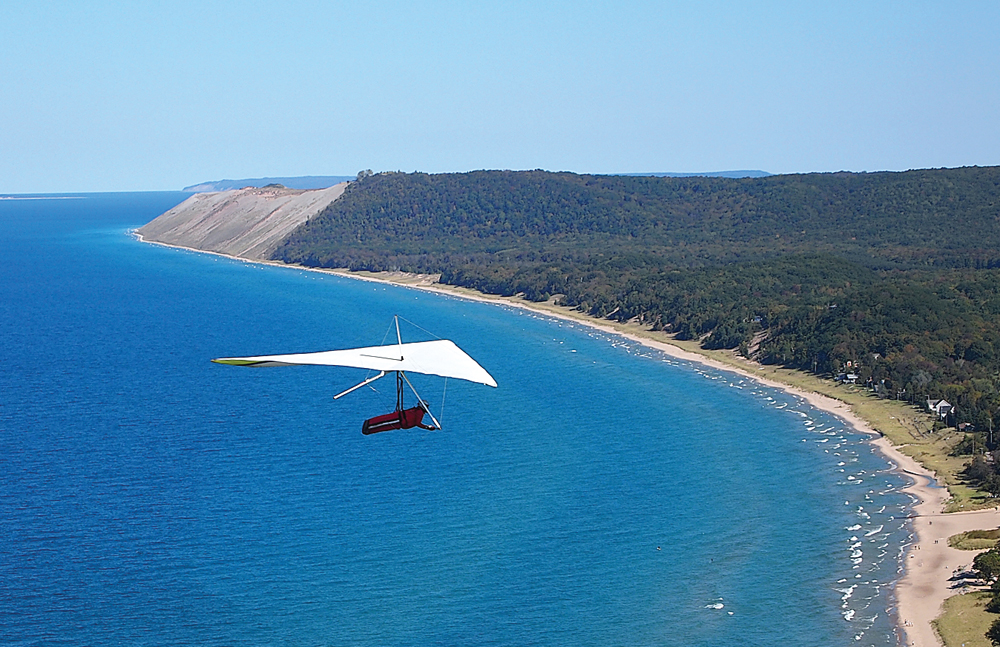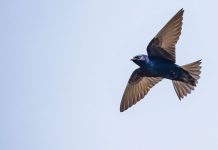Soaring high above the sweeping sand dunes and sparkling waters of Lake Michigan, boats and sunbathers are tiny dots along the shoreline. The distracting roar normally associated with conventional aircraft is replaced by the subtle whoosh of rushing wind.
Since the 1970s, Michigan organizations like the Northwest Soaring Club, Green Point Flyers Association and Dragon Fly Soaring Club have promoted glider flight across the Great Lakes region.
Based out of Wexford County near Cadillac, motor-free sailplane pilots at the Northwest Soaring Club keep sharp eyes on the weather. They’re searching for puffy cumulous clouds, which indicate the presence of “thermals” — a phenomenon that occurs when the sun warms the earth and air rises, creating the ideal scenario for soaring. Initially a glider is tethered to a single-engine plane and towed aloft prior to release (pictured below). Pilots gain altitude by gracefully circling amid the rising air, similar to an eagle on a warm summer’s day.
Flying the lakeshore is peaceful and tranquil — Lake Michigan smooths out the air before being pushed upward by the dunes.
— Ken Riemersma
These flights range from minutes to hours, depending upon conditions.
For up to an hour’s duration, the cost of one day’s club membership ($50) and between $35-$85, three different first-time introductory tandem flights with a club pilot can be experienced at release altitudes ranging from 3,000 to 5,300 feet above scenic twin Lakes Cadillac and Mitchell and Northern Michigan’s undulating hills.
Swept Away
Equipped with the “adelta” or “Rogallo” wing, modern hang gliders evolved from NASA engineer Francis Rogallo’s research on kites and parachutes in the 1960s. While Rogallo had presented the lightweight, durable and easily maneuvered delta-wing parachute as a way to bring spacecraft back to Earth, today’s product is designed to do the opposite.
The Green Point Flyers Association (GPFA) of Frankfort/Elberta, founded in 1978, is situated near scenic Sleeping Bear Dunes National Lakeshore. Once touted the nation’s “Sail Plane Capitol,” this region still draws hang gliders and paragliders from near and far. The GPFA is a privately owned club and pilots must be licensed to fly here, but the public is free to observe any time — and lessons from certified flight instructors are available by appointment.

“Flying the lakeshore is peaceful and tranquil — Lake Michigan smooths out the air before being pushed upward by the dunes,” notes Ken Riemersma, GPFA president. “This provides exceptionally smooth sustained lift, allowing flights of several hours at a time.”
Home to Hang Glide University (HGU) and Cloud 9 Sport Aviation, the Dragon Fly Soaring Club (DFSC) near Webberville was started by hang glider enthusiasts Tracy and Lisa Tillman in 1997. The DFSC offers “discovery flights” for first-time flyers as well as training for students looking to learn the ropes. Because of the relatively flat landscape, a specialized plane called a Dragon Fly transports hang gliders to altitudes of several thousand feet.
People are drawn to hang gliding for a variety of reasons, Tracy says. For one, it’s a fairly economical form of flight, but hang gliding also appeals to those who enjoy a multi-dimensional challenge.
“It’s like an airborne game of chess,” he notes. “The range of expertise covers a broad spectrum. Skimming along the ground doesn’t require a whole lot of experience, but gliding thousands of feet above the earth… Well, you should know what you’re doing before you give that a try.”

In 1975, Tracy reflects, when he was new to the sport, students typically began with a solo flight, which was risky for obvious reasons. These days, newcomers start out with an instructor and potentially dangerous situations are resolved before they become serious. Safety is paramount at Dragon Fly and pilots wear reserve parachutes for an added insurance.
However, he underscores, most accidents are avoidable with common sense.
“We try to mentor new pilots so they make good decisions in the air. There are some bold pilots out there, but they aren’t necessarily wise. The crashes that make headlines are often the result of foolish stunts gone bad.”
First taking to the air in a hang glider is an experience that awed Tracy — a lucid memory forever forged on his psyche. From running along the ground right before he launched to being swept up with elation as the earth fell away beneath his feet, he recalls every detail.
It was then what it remains today.
Nothing short of magical.
For more details, visit northwestsoaringclub.org and skydogsports.com/dfsc.

Which Wings Are Which?
While aircraft of all sizes are seen over Michigan, gliders aren’t as common. Dragon Fly’s Tracy Tillman clears up some of the misconceptions:
“A paraglider looks like a parachute without an engine, whereas a paraplane, or powered paraglider (PPG) is propeller-driven — what people often call an ‘ultra-light.’ Gliders with a fuselage and cockpit are called sailplanes.
“Hang gliders are similar to kites with a tubular frame system beneath a single wing,” he says. Evolving from kite skiing in the late 1960s, early hang gliders basically parachuted down, but modern hang gliders are aerodynamically advanced.”

Because gliders rely upon nature (rather than motors) for flight, specific wind conditions are paramount. To self launch from the Sleeping Bear overlook sites, the wind must range between 8-20 miles per hour and be from the northwest or southwest. Conversely, when launching at Empire Bluffs, the wind must be from the north or northwest.
Early autumn is the ideal time to soar because of the cool air blowing across the warm water, Timman adds, which creates thermals.
“It gives me a ceaseless sense of wonder that I can take a 30-pound wing and harness out of my backpack, reach up into the wind and soar with eagles,” shared Bill Fifer, owner of Traverse City Paragliders and a seasoned instructor of more than 40 years (tcparagliders.com). “It is very satisfying to watch that same sense of wonder grow in my students as they transition from small training flights to 400 foot bluffs and finally to soaring over the bluffs all by themselves.”








Facebook Comments